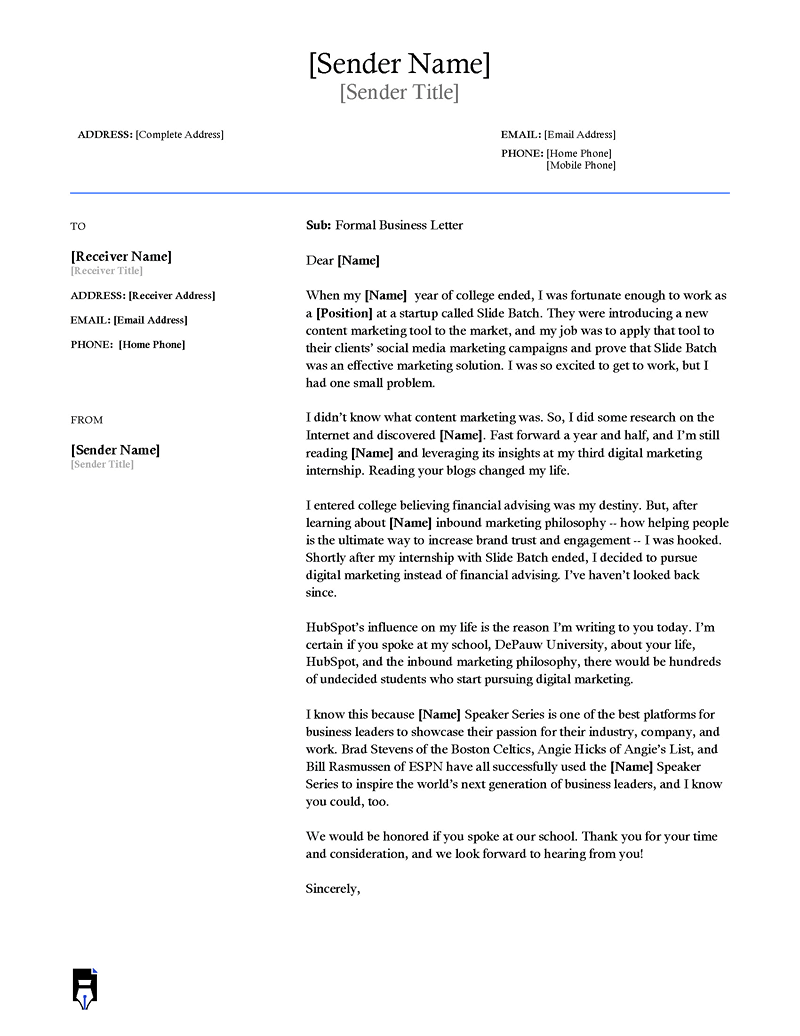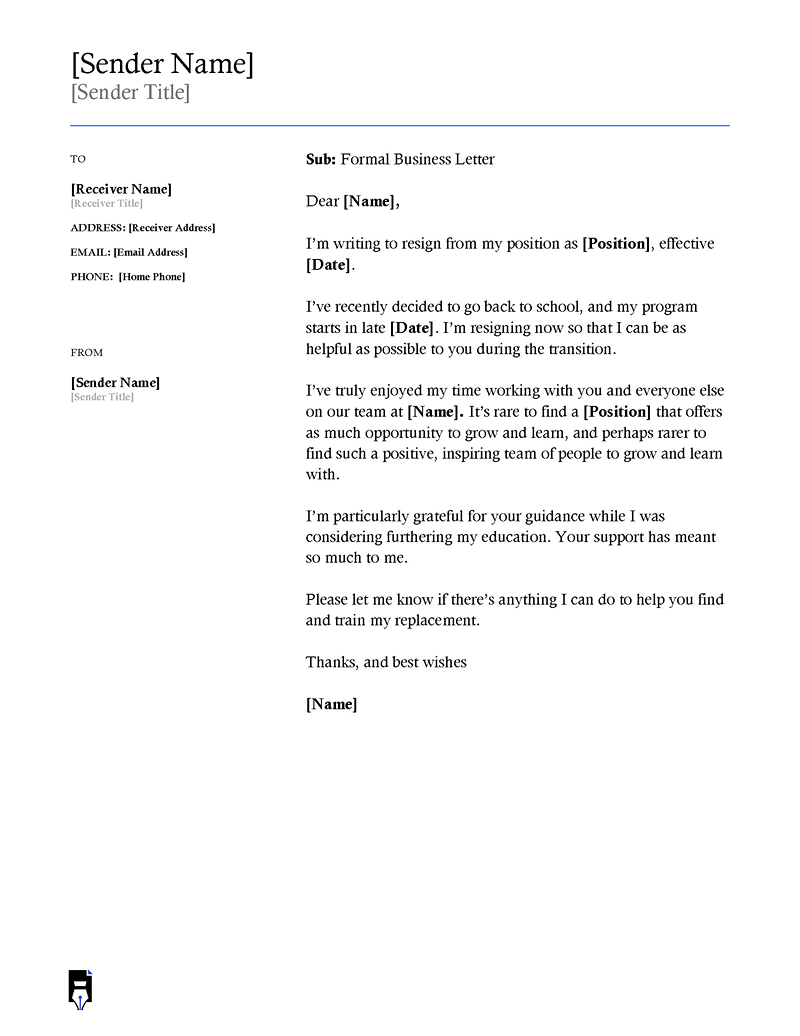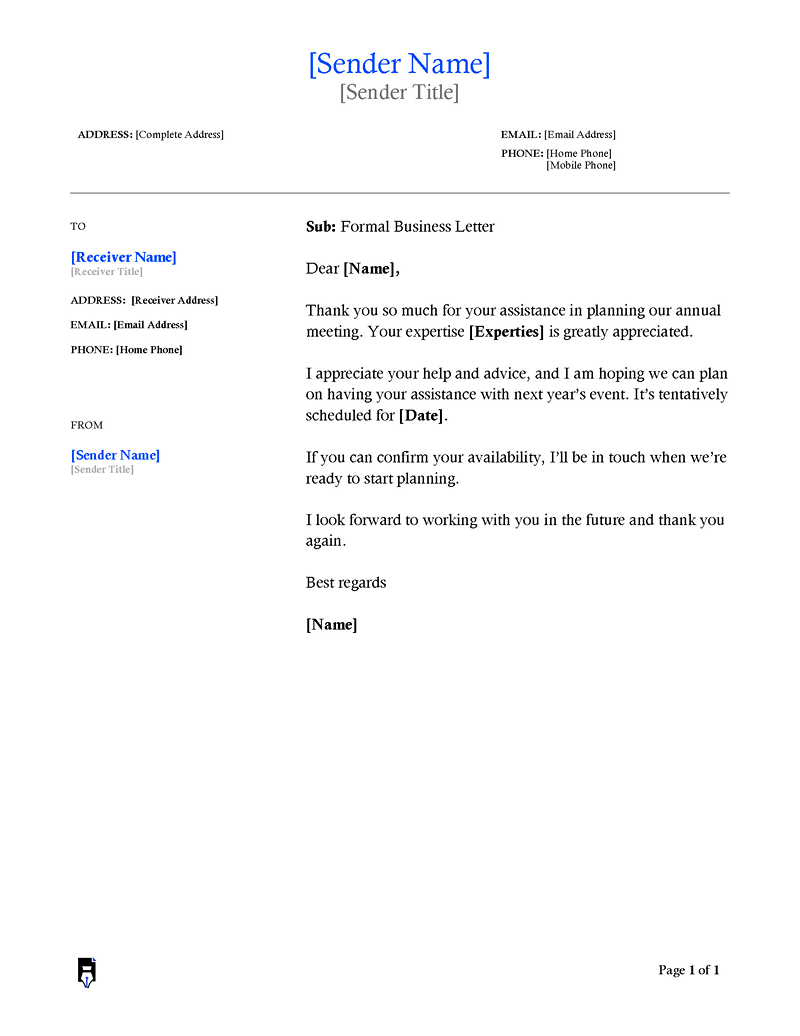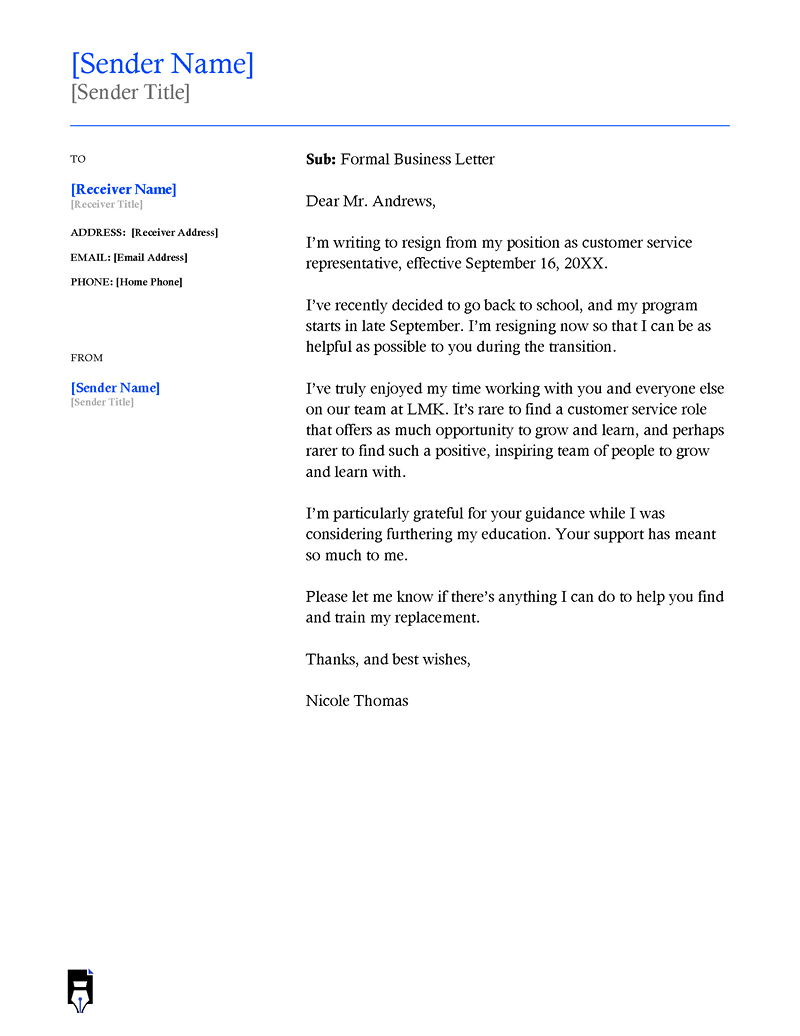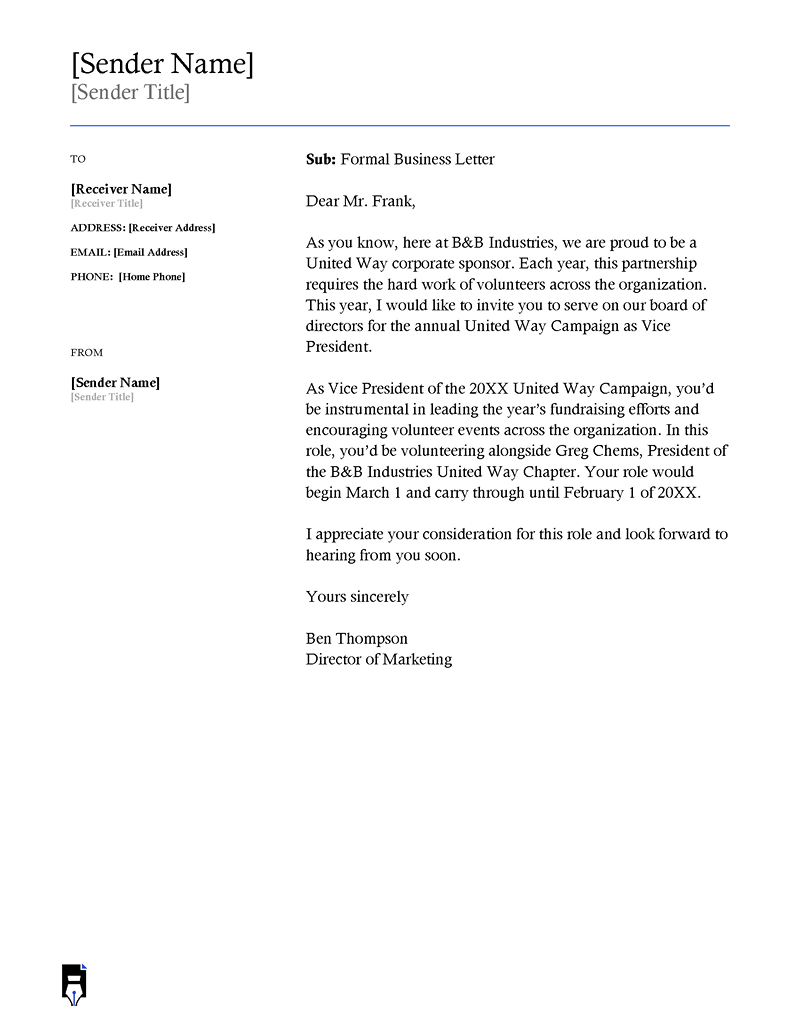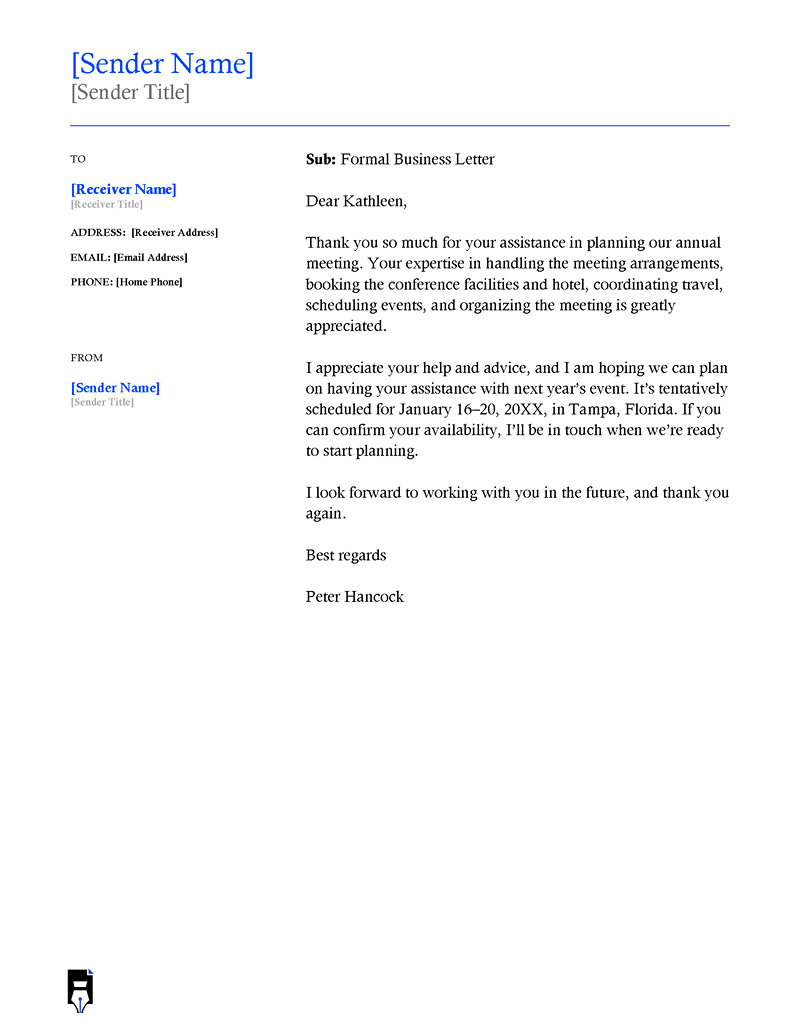A business letter is a formal document used to correspond with other organizations. It should be written formally to leave a positive impression on the recipient. A professionally written business letter shows the sender is completely professional, serious, and wants to communicate clearly. It is imperative to follow basic conventions for such correspondence, including layout, tone, and language. If one writes many such letters, one may save time by downloading a business letter template with a pre-formatted structure that can easily be customized.
There are several types of business letters written for official correspondence, such as inquiry, sales, thank you, or cover letters, to name a few. If you want to write a formal letter, this article will guide you on how to do so.
Download Free Templates
Given below are formal business letter templates:
Formatting Styles of an Official Letter
There are three most commonly used formats for formal correspondence in the U.S. They are discussed below:
Block format
In the block format, also known as the full-block format, all text is single-spaced and aligned to the left margin of the page. However, paragraphs in the body are double-spaced. Each sentence of the letter starts at the left margin, and there are no indents at the beginning of each paragraph. The block letter format is the most commonly used format for professional letters.
Semi-block format
The semi-block format is the least popular letter format. It is similar to the block format but has a few minor differences in the layout. The first line of each paragraph is indented. Sender’s address, date, closing, signature, and printed name are all indented to the right half of the page
Modified block format
In a modified block business letter, the heading, complimentary close, signature, and identification are aligned to the right. The address, salutation, body, and enclosures are aligned to the left. The first sentences of paragraphs are indented.
Components of a Formal Letter
It is vital to follow the conventions of a formal business letter to ensure that it is professional and thorough enough to communicate your message effectively.
The components of a formal letter are discussed below:
Header
The header is the section at the top of the letter that includes your organization’s information. like a name, physical address, phone number, and email address. Leave one space and include the current calendar date. Then include the recipient’s name, designation, physical address, and contact information after one space.
The header may be presented as shown below:
Daly Industrial Hardware
2410 Commonwealth Ave.
Auburn Hills, Michigan (MI), 48326
(248) 373-2082
www.dalyindustrial.com
March 23, 2023
Adair Malone
16411 1st St.
Channelview, Texas (TX), 77530
(281) 452-5995
[email protected]
Salutation
The salutation is the greeting used to address the recipient. Leave one space after the recipient’s address and include a proper salutation. There are a few different options for salutation in formal letters, depending on your relationship with the recipient and the level of formality of the letter.
Some usual options include:
- Dear [Name], This formal salutation is appropriate for most business letters. Do not forget to include a comma after this salutation.
- To Whom It May Concern: This salutation can be used when you do not know the recipient’s name or address the letter to an organization rather than an individual. Remember to include a colon after this salutation.
Choose a salutation appropriate for the tone and purpose of your letter. Using the wrong greeting risks creating a negative impression that may make it difficult for the recipient to take your letter seriously.
Body
The body contains the main contents of the letter and outlines the message you want to convey. It is divided into paragraphs, with each paragraph addressing a specific topic. In the body of a formal business letter, you may include the following:
- Introduction: An opening that provides a brief overview of the purpose of your communication.
- Main Body: The main points you want to convey. Address each main issue in a separate paragraph.
- Closing: A summary of your main points and any closing requests.
Example:
Following your advertisement in The Tribune, I am writing to tender my application for the sales manager position at Apollo Inc.
In my current position at Pep Industries, I have successfully developed and implemented several campaigns that have increased sales and brand awareness.
My skills and experience will make me a valuable asset to your team. I am excited about the prospect of contributing to Apollo Inc. and believe that I could make a positive impact in this role.
Thank you for considering my application.
Closing
A closing salutation is a greeting at the end of the letter. A proper closing salutation and your signature are placed after one space following the last paragraph.
The salutation is a polite way to end the letter and serves as a transition between the body of the letter and the signature. A few options for a closing salutation in a formal business letter exist.
Some options include:
“Sincerely”: This is a formal closing applicable for most business letters.
“Best regards”: This is a less formal closing for more casual business letters or when you have a close relationship with the recipient.
“Thank you”: This closing is mostly used when you are requesting something instead of an informational correspondence, for example, for considering your application or providing information.
If you did not include your name in the header, you could include it after the closing salutation, as shown below:
Sincerely,
Fran Reagan
Signoff
A formal business letter is signed off with a handwritten signature, which appears at the end of the letter below the closing salutation and above your name. The signature authenticates the letter and shows it is an official document. Your designation can follow the signature.
Business Letter Template
[Your Name]
[Address]
[Phone Number]
[Email]
[Date]
[Recipient’s Name]
[Title]
[Organization Name]
[Address]
[Phone Number]
Dear [Name],
I am writing to make an insurance claim for a recent [type of incident] on [date of the incident] at [location]. My policy number is [Policy Number], and therefore I am entitled to compensation.
I am requesting that the insurance company cover the costs of this incident, as specified in the policy. Feel free to call me if you have any concerns or require additional information.
Enclosed with this letter are copies of the police report and invoices for repairs and replacements.
I appreciate your prompt attention to this matter.
[Closing Salutation],
[Your Signature]
Business Letter Sample
Savanna Electronics Inc.
7251 Las Plumas Ln.
Tujunga, California (CA), 91042
(818) 293-0186
August 16, 2023
Trident Marketing
83 Front St.
Leeds, Massachusetts (MA), 01053
(413) 586-1145
To Whom It May Concern:
I would like to schedule a meeting to discuss the possibility of collaborating on a marketing campaign for our new flagship product launch. As a leading marketing firm, Trident Marketing would be the ideal partner for this campaign.
Our new smartphone, the Savanna X6, is a revolutionary product that is sure to become popular with consumers. The Savanna X6 boasts a plethora of upgrades and new features that make it an ideal smartphone. Many retailers have expressed interest in our product and can generate significant sales with the right marketing strategy.
I would like to schedule a meeting to discuss the details of this campaign and see how Trident Marketing can be a part of it. Please let me know a convenient time and date for a meeting, and I will schedule it.
I look forward to discussing this further.
Sincerely,
Casey Pip
Senior Marketing Manager
How to Format a Formal Letter
A properly formatted business letter is easier to read and understand and leaves a positive impression on the recipient. It is a professional document and should be treated as such.
By adhering to the following formatting guidelines, you can ensure that your letter looks professional and is well received:
Style
Different letter formats are better suited for various purposes. Block format is the most formal and is befitting for business letters, while modified block and semi-block formats are less formal and may be used for casual or friendly letters. Moreover, maintain a formal tone and remain respectful.
Fonts
Use the same font throughout the letter to create a cohesive and professional appearance. Times New Roman 12 is the preferred font and font size, though other commonly used fonts such as Arial, Calibri, or Helvetica may also be appropriate. Legibility is vital regarding fonts and font sizes, so do not be creative and avoid gothic or cursive fonts.
Spacing and indentation
It would be best to use proper spacing and indentation to create a professional and organized appearance in your business letter. Use single spacing for the body of the letter and double spacing between paragraphs to make the letter appear organized. Indent the first line of every paragraph to create structure in your letter.
Margins
Typically, margins are 1 inch (25.4 mm) on all sides of the document. You can adjust these margins depending on the needs of the letter, but it is generally best to use these standard margins as much as possible.
How to Be Professional in Business Correspondence: 8 Tips
A business letter that is not written properly and presented well can reflect poorly on your company and damage your reputation. Here are some useful tips to consider when writing a formal letter:
Use a professional tone
A formal tone helps convey the credibility of the matter being presented in your letter. Avoid using colloquial language or slang. Use formal language that is appropriate for such correspondence. Be polite and respectful in tone even when making a complaint, as it is imperative to maintain professionalism.
Check your spelling and typographical errors
Carefully check your spelling and any typographical errors to ensure your letter is free of mistakes. Most word processing softwares have spell checkers to help you identify and correct any mistakes. Even if you use a spell checker, carefully reviewing the letter is still a good idea to ensure all your words are spelled correctly.
Check your grammar
Proofread the document for any grammatical errors. Reading the text backward can also be beneficial, starting with the last sentence and moving forward to the first. This can help you focus on individual words and phrases rather than the overall structure of the letter. Conversely, word processing programs have built-in grammar checkers that identify and correct grammatical errors, and they can also be utilized.
Check your punctuation
It is crucial to use correct punctuation since the letter represents your organization and can affect how others perceive your professionalism. Carefully reading your letter and paying attention to punctuation can help you find errors. It can also help to read the letter aloud to identify any punctuation errors.
Organize your information logically
Before you begin writing, you should clearly determine the letter’s purpose. This will help you decide which information to include and the order in which to present it. Consider creating an outline to help you organize your thoughts and make sure that your letter contains all the necessary information. Start by listing the main points you want to cover, and then add supporting details underneath each point.
Understand the recipient
Consider the possible needs of the recipient when writing your letter. Are they looking for information about a specific product or service? Are they looking for a solution to a problem? Understanding their perspective can help you present the information in a manner that meets their needs.
Use personal pronouns
The use of personal pronouns such as “I,” “we,” “you,” and “they” can make your letter seem less formal and less professional. Using personal pronouns may be appropriate in certain circumstances, such as when responding specifically to the reader’s questions or concerns. In these cases, it is essential to use the pronouns carefully and in a way that maintains a professional and respectful tone.
Use active voice
Passive voice sentences often require more words and can be less straightforward than active voice. So, present your thoughts in an active voice when writing a formal letter, making the writing more direct and engaging. It will also make the writing more concise.
Conclusion
A formal letter is a professional communication method requiring meticulous attention to detail. To appear professional in your letter, use a clear and concise writing style, make sure the letter is well-organized and simple to read, and use proper language, spelling, and punctuation. It is also crucial to consider your letter’s recipient and tailor the content and tone to match their expectations and requirements. This may include doing background research on the recipient, considering their perspective, and being aware of cultural differences that may affect how the letter is perceived.
You can use a template with placeholders for all the necessary information to write a formal letter. A template serves as a useful guide for the proper format and tone, and it is very convenient to use. You can be sure that your next business correspondence is professional and successful in conveying your message by adhering to the guidelines outlined in this article.
